In the field of landscape design, rows of trees with red leaves stand out as living masterpieces of nature. These trees, adorned with vibrant crimson and burgundy foliage, add a striking and dynamic dimension to any outdoor setting. From the iconic Japanese maple with its fiery colors to the crabapple with its elegant silver-red flowers, each tree brings its own character to the natural canvas. Whether as a rich tapestry of autumn or as a year-round spectacle, these trees not only evoke feelings of warmth and energy but also demonstrate the breathtaking artistry of the natural world.
Join us in this article to explore the enchanting world of red-leafed trees and embark on a journey through a kaleidoscope of color that redefines the beauty of the great outdoors.
Different Types of Trees with Red Leaves
Black Tupelo

Thriving in USDA Zones 4 to 9, the Black Tupelo, scientifically named Nyssa sylvatica, stands as a symbol of nature’s beauty and change. Celebrated as one of the most attractive trees, it undergoes a stunning metamorphosis, with dark green leaves in summer forming a lush canopy. Yet, it is in the fall that true magic emerges. The same branches that once cradled green foliage transform into a spectacular display of red, yellow, orange, and purple hues, creating a breathtaking autumnal tapestry.
October Glory

October Glory, scientifically known as Acer rubrum ‘October Glory,’ is a tree that graces landscapes with a display of dual foliage colors. Flourishing in USDA Zones 3 to 8, it unfolds glossy green leaves in spring, transforming into a radiant shade of red during the summer and late fall. This remarkable tree offers a visual symphony of colors, making it a standout choice for those seeking dynamic and ever-changing beauty in their outdoor spaces.
Red Maple
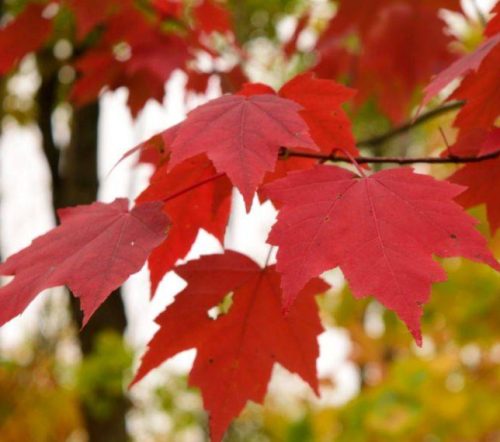
The Red Maple, scientifically known as Acer rubrum and thriving in USDA Zones 3 to 9, is a year-round spectacle of nature’s beauty. With a festive display that spans the seasons, this magnificent tree showcases buds in winter, blossoms during spring, leafstalks in summer, and a stunning finale of vibrant red leaves in the fall.
Garnet Maple
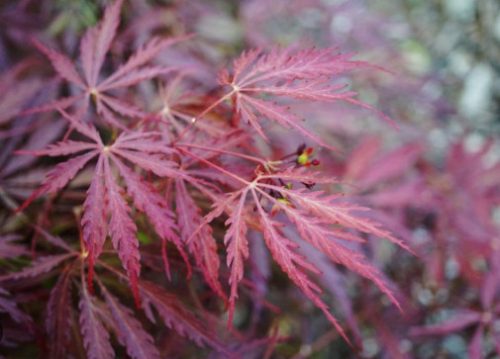
The Garnet Maple, scientifically named Acer palmatum dissectum ‘Garnet’ and thriving in USDA Zones 5 to 8, is an exquisite lace-leaf Japanese maple. Its red foliage maintains a red-orange hue throughout the growing season, transitioning to purple-green in late summer before culminating in a vibrant bright red display in the fall. This ornamental beauty adds a touch of elegance to landscapes with its ever-changing palette of colors, making it a sought-after choice for garden enthusiasts.
Red Japanese Maple
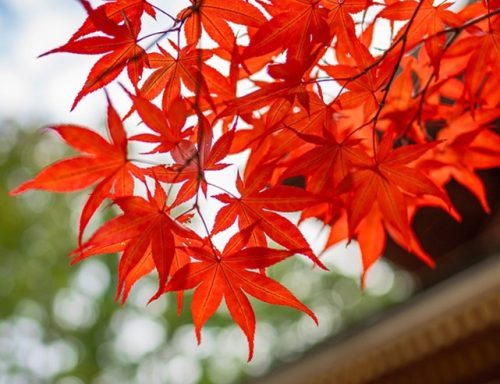
The Red Japanese Maple, scientifically known as Acer Palmatum ‘Beni-Maiko,’ is a charming dwarf tree that gracefully reaches 4-6 feet in height. With its 3-5 lobed red leaves, this variety is an excellent choice for bonsai enthusiasts and thrives in USDA Zones 5 to 8. Its compact size makes it particularly adaptable to container gardening, adding a touch of vibrant elegance to patios or small outdoor spaces.
American Sweetgum
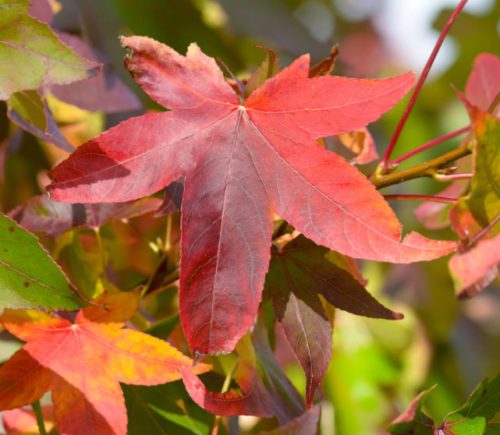
The American Sweetgum, scientifically labeled Liquidambar styraciflua and thriving in USDA Zones 6 to 10, transforms into a vibrant spectacle during fall. Exhibiting a array of red, yellow, orange, and purple hues, this majestic tree typically reaches heights of 60-80 feet, adorned with sizable leaves.
Red-Leaf Euphorbia
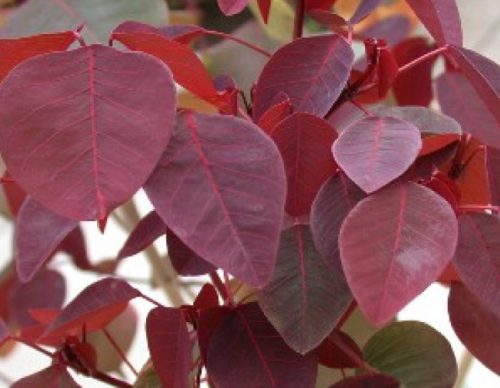
The Red-Leaf Euphorbia, scientifically known as Euphorbia Cotinifolia and thriving in USDA Zones 9 to 11, captivates with heart-shaped leaves adorned in a deep maroon-red hue. Harmonizing seamlessly with its red stems, this plant grows to a height of 6-8 feet, adding a touch of elegance and color to its surroundings.
Cranberry Hibiscus
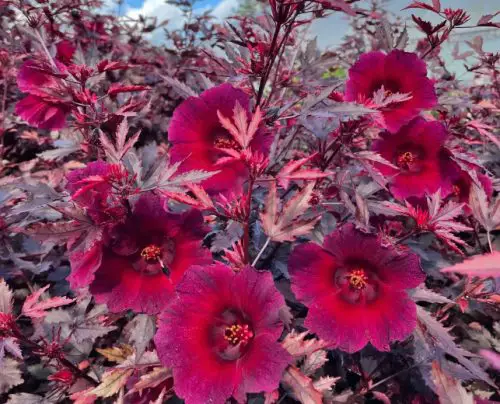
Cranberry Hibiscus, scientifically known as Hibiscus acetosella, thrives in USDA Zones 7-11. Its stunning copper and burgundy leaves resemble red maple, while vibrant red or yellow funnel-shaped flowers add to its allure. Ideal for tropical gardens, this shrub captivates with its perfect red foliage.
Cristina Ficus
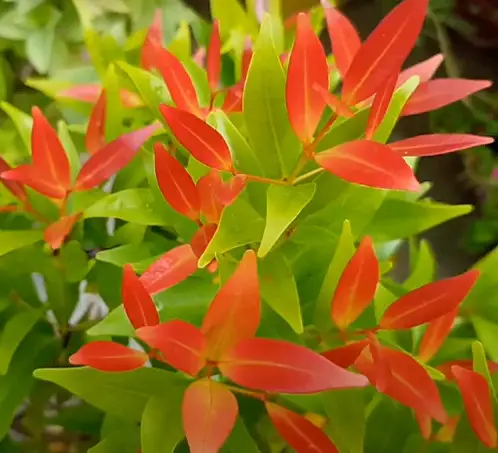
Cristina Ficus, scientifically known as Ficus ‘Cristina,’ thrives in the USDA Zones 9-11. This plant features dense leaves in a striking blend of deep maroon-red and green hues, creating a visually appealing contrast. Its versatility shines as both an excellent hedge and a charming addition to garden landscapes, enhancing the overall aesthetic with its vibrant foliage. Ideal for those seeking a distinctive and attractive plant for their outdoor spaces.
Chinese Fringe Flower
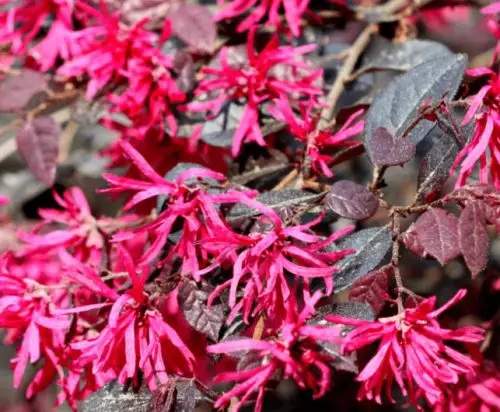
Chinese Fringe Flower, scientifically identified as Loropetalum chinense, is a fast-growing shrub that thrives in USDA Zones 7-11. Its beauty lies in its deep red leaves, which are further enhanced by the appearance of pink or white flowers during spring. This mesmerizing combination of vibrant foliage and flowers makes it a must-have for any garden, adding color and elegance to outdoor spaces.
Weeping Japanese Maple
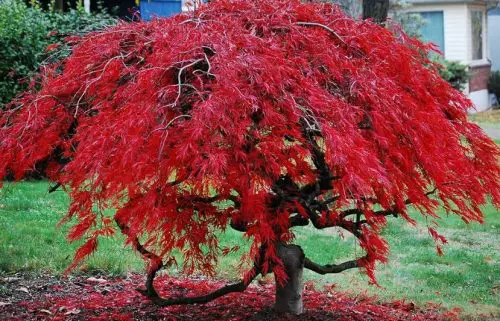
The Weeping Japanese Maple, scientifically known as Acer palmatum ‘Cascade,’ flourishes in USDA Zones 5-8. Sought for its graceful arching branches, this new cultivar showcases vibrant new growth on orange-red stems in spring, evolving into a coppery red as it matures. A picturesque addition to any landscape, it embodies elegance and seasonal beauty.
Photinia
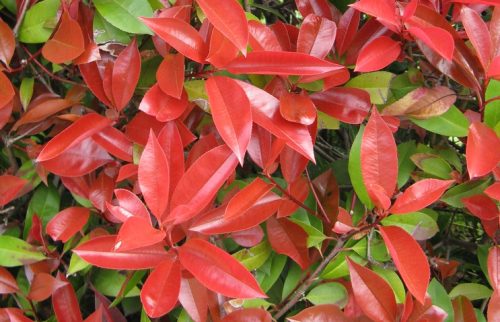
The Photinia, scientifically known as Photinia x fraseri ‘Red Robin,’ thrives in USDA Zones 6-8. Renowned as the Christmas Berry Tree or Red Tip Photinia, this enchanting tree unveils vibrant red new growth in spring, creating a striking contrast against its glossy green mature leaves. A addition to any landscape, it brings beauty and color throughout the seasons.
Royal Burgundy

The Royal Burgundy, scientifically identified as Prunus serrulata ‘Royal Burgundy,’ thrives in USDA Zones 5-8. Commonly referred to as the Royal Burgundy Flowering Cherry, this deciduous tree exhibits a vase-like shape, reaching heights of 14-20 feet with a spread of 12-15 feet. Its distinctive feature lies in the striking red-purple leaves, adding a touch of regal elegance to any landscape.
Laceleaf Japanese Maple
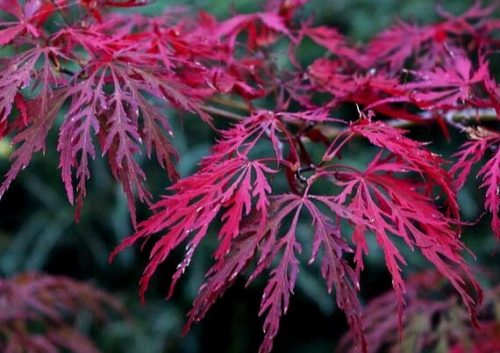
The Laceleaf Japanese Maple, scientifically labeled Acer palmatum dissectum ‘Crimson Queen,’ thrives in USDA Zones 5-9. Renowned for its unique and vibrant leaf color retention, this popular variety reaches a height of 8-10 feet with a spread of 10-12 feet. Its compact size makes it an ideal choice for landscapes and smaller gardens, where its striking foliage adds beauty and character.
Smokebush
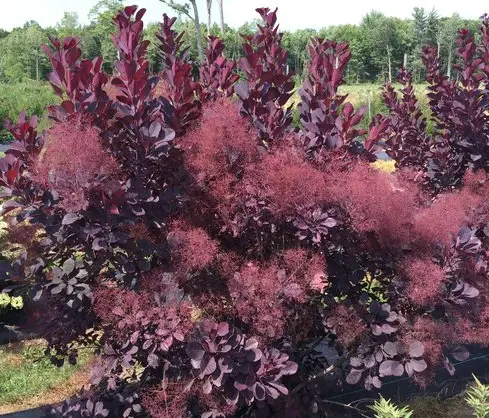
The Smokebush, scientifically named Cotinus ‘Grace,’ thrives in USDA Zones 3-9. A robust hybrid of Cotinus coggygria ‘Velvet Cloak’ and the American Smoke Tree (Cotinus obovatus), this tree boasts round leaves in shades of rich red to purple. Its foliage undergoes color transformations with the changing seasons, adding dynamic beauty to the landscape.
Redbud
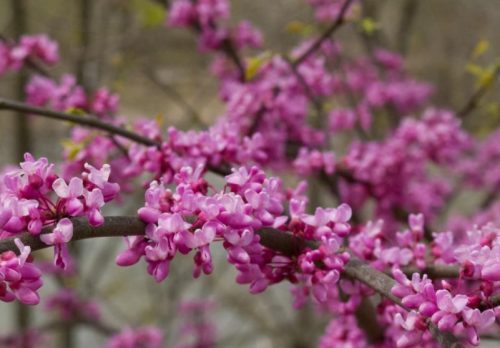
Redbud, scientifically known as Cercis canadensis ‘Forest Pansy’, thrives in USDA Zones 5-9. Awarded a Garden Merit by the Royal Horticultural Society for its stunning foliage, this small deciduous tree reaches a height of 20-30 feet. Its heart-shaped leaves start out bright orange and turn deep chestnut, adding beauty to the garden landscape.
Japanese Maple
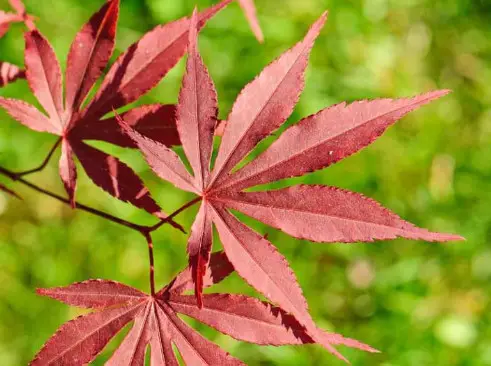
The Japanese Maple, scientifically known as Acer palmatum ‘Atropurpureum,’ thrives in USDA Zones 5-8. Referred to as ‘Blood Leaf,’ it’s admired for its distinctive foliage that undergoes color changes with the seasons. In spring, the leaves exhibit a rich purple hue, deepening to scarlet red in the fall, creating a visually stunning transformation.
Purple Leaf Plum Tree
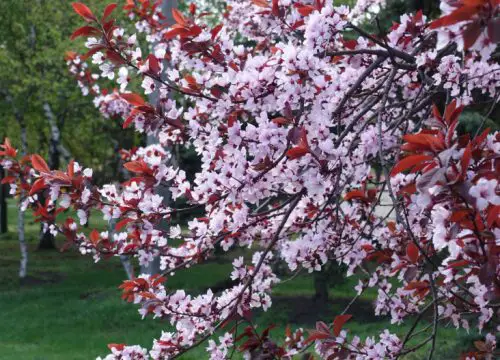
The Purple Leaf Plum Tree, scientifically labeled Prunus cerasifera ‘Atropurpurea,’ thrives in USDA Zones 5-8. Recognized as a cherry plum or flowering plum tree, this petite tree reaches heights of 15-25 feet. Adorned with red-purple foliage, it offers ornamental white spring blooms, creating a delightful and picturesque display in any landscape.
Red Silver Flowering Crabapple
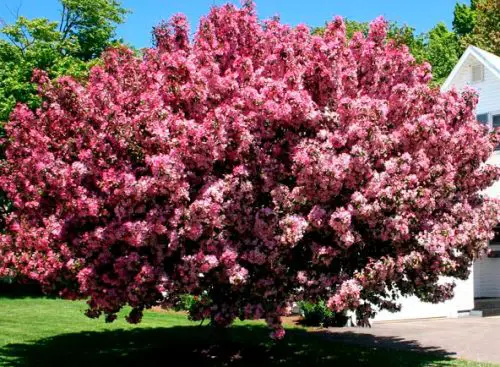
The Red Silver Flowering Crabapple, scientifically named Malus hybrida, thrives in USDA Zones 5-9. A semi-weeping and spreading deciduous tree, it spans 10-20 feet in width. Characterized by oval-shaped, dense red or purple leaves, this tree adds vibrant foliage and a graceful presence to the landscape.
Red Norway Maple
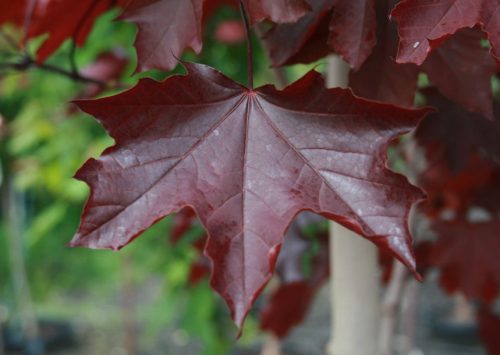
The Red Norway Maple, scientifically identified as Acer platanoides ‘Royal Red,’ thrives in USDA Zones 4-8. Known as the Crimson King Maple, this flowering tree reaches heights of 30-50 feet, gracing the landscape with its stunning red-purple leaves throughout the summer. Notably resilient, it tolerates drought, shade, and coastal conditions, making it a versatile and enduring addition to diverse environments.
Copper Beech
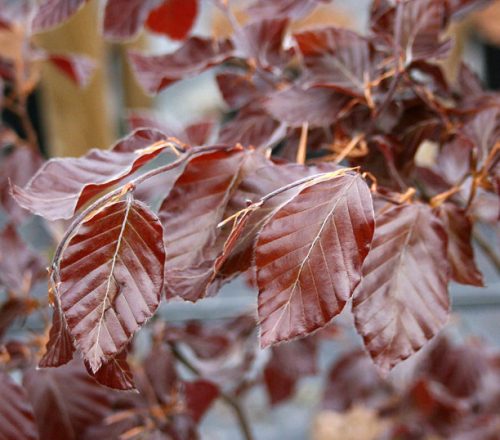
The Copper Beech, scientifically labeled Fagus sylvatica f. purpurea, thrives in USDA Zones 3-7. Commonly known as the purple beech, this tree is renowned for its unique, tornado-shaped leaves in shades of red to purple, adorned with captivating criss-cross patterns. A popular choice, it adds a touch of distinctive beauty to landscapes.
People Who Read This Also Read:






